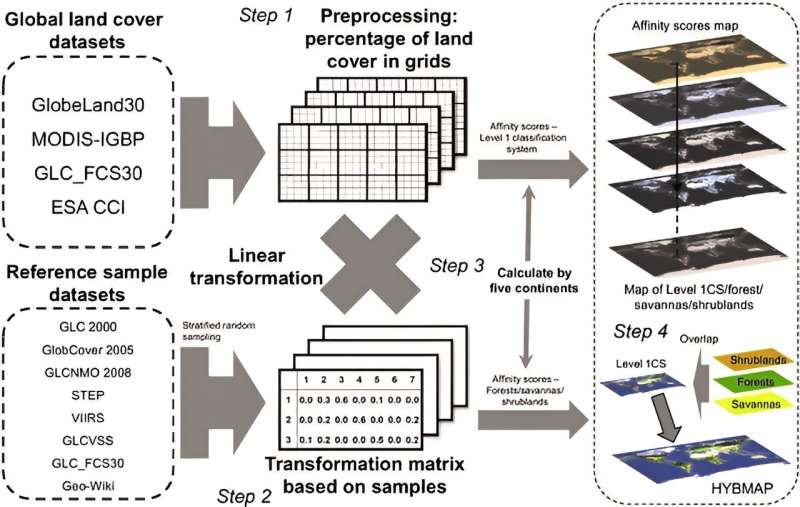This article has been reviewed according to Science X's editorial process and policies. Editors have highlighted the following attributes while ensuring the content's credibility:
fact-checked
proofread
Research presents a map of global land cover from 2000–2020

A new study introduces the Hybrid Global Annual 1-km International Geosphere-Biosphere Programme (IGBP) Land Cover Maps for the period 2000–2020.
This innovative dataset, free to access, marks a significant step forward in global land cover mapping, addressing longstanding issues of disagreement and incompatible classification systems among existing land cover products.
Global land cover data, essential for environmental research, are plagued by inconsistencies across different datasets, complicating global change studies. The diversity in classification systems and methodologies challenges the creation of a unified, accurate land cover map. Addressing these discrepancies is crucial for effectively monitoring ecological transformations and supporting sustainable development, highlighting the urgent need for integrated and reliable land cover information.
In March 2024, researchers from Peking University published a study in the Journal of Remote Sensing. They integrated four major land cover products using a hierarchical International Geosphere-Biosphere Programme (IGBP) classification system, leading to the creation of a hybrid global annual land cover product (HYBMAP).
This hybrid approach harmonizes disparate land cover datasets and offers improved resolution and accuracy.
This research intricately weaves together data from four major land cover datasets utilizing a refined IGBP classification system. By harnessing a global collection of reference samples for unprecedented accuracy, HYBMAP mitigates the longstanding issue of discrepancies among existing datasets, showcasing a remarkable reduction in disagreement by up to 20.1%.
What sets HYBMAP apart is its dual focus on enhancing accuracy and resolution, achieving an overall accuracy of 75.5%, thereby outperforming the individual datasets it integrates. This meticulous synthesis not only harmonizes divergent classification systems but also encapsulates temporal changes, identifying trends such as the rapid expansion of built-up areas.
Zaichun Zhu, the corresponding author, says, "HYBMAP's integration of multiple data sources and its enhanced accuracy provide a more reliable foundation for studying global biogeochemical cycles and ecosystem services."
HYBMAP offers a consistent and reliable global land cover time series, essential for environmental monitoring, policy-making, and climate change research. Its enhanced accuracy and resolution will improve our understanding of land use's impact on global ecosystems and help in the development of sustainable land management strategies.
More information: Yuhang Luo et al, Hybrid Global Annual 1-km IGBP Land Cover Maps for the Period 2000–2020, Journal of Remote Sensing (2024). DOI: 10.34133/remotesensing.0122
Provided by Journal of Remote Sensing




















